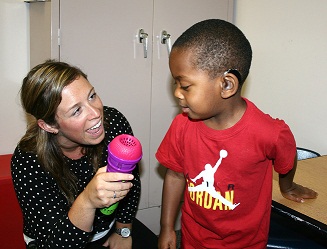Overview

The Speech-Language Pathology Department evaluates children with speech, language, cognitive, feeding/swallowing, and auditory impairments, and our pediatric speech pathologists or (pediatric speech therapists) provide specialized therapy to develop their language and communication skills.
Pediatric speech pathology offers individual, paired-peer, and group therapy, along with community and caregiver education for those who are concerned about their child’s speech, language or communication skills. Learn more about our pediatric speech pathology services.
Signs of Early Communications Problems
Your child may have a speech problem or communication disorder and should see one of our pediatric speech pathologists if he or she:
- Never gestures or imitates
- Cannot associate a name with an object
- Does not talk frequently or at all
- Cannot understand speech
- Almost never imitates speech
For signs of early communication problems by age group before seeing pediatric speech-language pathologists (or pediatric speech therapists), click here.
For Referring Physicians
Please print and complete the Developmental Services Prescription Form.
Upcoming Events
Pediatric Voice: Empowering Vocal Health And Wellness
January 20, 2024, 9:00 am-4:00 pm PST
Live Online Seminar – 6 Hours of CEU Credit
This course focuses on practical techniques for assessing and treating pediatric voice disorders that can be utilized in private practice as well as school-based settings. Specific emphasis will be placed on therapeutic principles, exercises, and activities for the treatment of hyperfunction. Special considerations and management of vocal cord dysfunction and affirming voice care will be discussed.